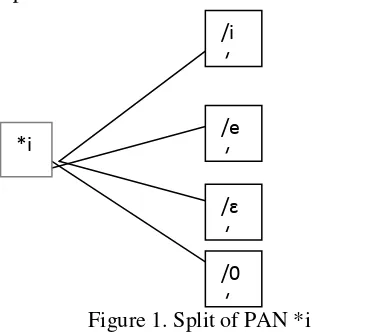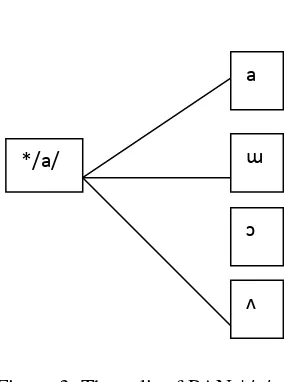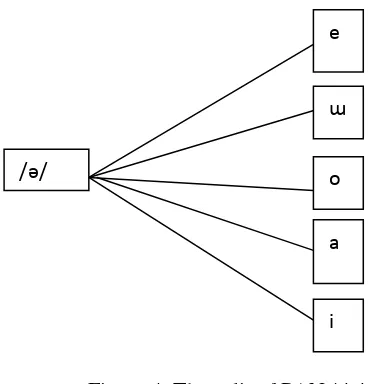Jurnal TUTUR, Vol. 3 No. 1. Pebruari 2017
ISSN 2442-3475 ASOSIASI PENELITI BAHASA-BAHASA LOKAL (APBL)
48
VOWEL SPLIT FROM PROTO-AUSTRONESIAN INTO ACEHNESE
Nurmaida
SMA Negeri 1 Nisam Kab. Aceh Utara almaidaahlam@yahoo.com
ABSTRACT
Bahasa Aceh (BA) is one of the Austronesian languages spoken by the people in the province of Aceh. BA is regarded inherit some characteristics of proto-Austronesian. It can be proved by linguistic evidences of Austronesian languages found in BA. These evidences are inherited in BA in limear and also in innovation. One of the innovation inheritances is vowel split. It has been found that PAN */i/ splitted to /i/, /e/, /ɛ/ and /o/. PAN */u/ split to /u/, /ɛ/, /o/, /ɯ/. PAN */a/ experienced split to /a/, /ɯ/ ɔ/, /ʌ/.PAN * /ә/ experienced split to to /ә/, /a/, /ɯ/, /o/ and /i/.
INTRODUCTION
The Austronesian language family has about 1200 members which are spoken by some 270 million people. Austronesian languages range from Malagasy (in Madagascar and on the island of Mayotte) in the western part of Indian Ocean to Rapanui or Easter Island in southeastern part of the Pasific Ocean, and from the Formosan languages in Taiwan and Hawaiian in northen reaches to the Pasific to Maori in New Zealand. Austronesian languages are spoken in the Phillippines, Brunei, Polynesia, Micronesia, Melanesia, and most of Indonesia and Malaysia (Adelaar 2005:1).
Bahasa Aceh (BA) is one of the Austronesian languages spoken by the people in the province of Aceh. BA is mainly spoken in some districts such as Aceh Utara, Bireuen, Pidie, Aceh Besar, Meulaboh, and some areas in Aceh Selatan. Besides the BA, there some other languages live in Aceh which share different characteristics with the language of BA itself. The languages are Tamiang spoken in Tamiang which shares the characteristic of Malay, Gayo is spoken in Central Aceh shares the characteristic of Bataknese, Jamee spoken in some part s in West and South Aceh shares the characteristic of Minangkabau language, and Devayan, spoken in the island of Simeulu has its own chracteristic. Although the languages which are mentioned above live and be spoken in Aceh, but the language which is considered as the BA language is the language that are spoken in the coastal Aceh suach as in North Aceh , Bireuen, Pidie, Aceh Besar, Meulaboh and Aceh Selatan.
Jurnal TUTUR, Vol. 3 No. 1. Pebruari 2017
ISSN 2442-3475 ASOSIASI PENELITI BAHASA-BAHASA LOKAL (APBL)
49 REVIEW OF RELATED LITERATURE
Thurgood (1997) studies the internal relatiionships and linguistic developments of Chamic languages. In sixth century, Cham became the lingua franca of the Champa kingdom in South Vietnam. It was spoken undifferentiated dialect chain extending along the coast of Vietnam and possibly even connecting with the east coast of Malaysia. Vietnam territorial expansion toward the South force Cham speakers to spread over a wider area and the dialect chain developed into distinct Chamic languages includingTsai (Hainan), Rade, Jarai, Haroi, Charu, Roglai, Phan Ram Cham, and Western Cham (Cambodia) (Adelaar 2005:17). On form of Chamic, later to become Acehnese on Sumatera‘s north coast, must have split off at earlier date but already after a dialect chain had begun to form. Remarkably, Thurgood considers Acehnese as a Chamic language directly sub-groupng wih Roglai.
Vowel System of PAN
Proto Austronesian is reconstructed by reconstructing sets of correspondences among consonants in various Austronesian languages according to the comparative method. Below are proto- Austronesian vowel phonemes reconstructed by Robert Blust, a professor of linguistics at the University of Hawaii at Manoa.
Blust reconstructed the vowel phonemes of PAN as follows: 1. *i : high - front vowel.
2. *ә : high-central vowels 3. *u : high- back wovels 4. *a : mid- low vowel
Vowel System of BA
According to Asyik (1987: 17) Acehnese vowels consist of ten oral vowels and seven nasal vowels. The oral vowels consist of three high vowels /i/, /ɯ/ and /u/, three mid-high vowels /e/, /ә/, and /o , three low-mid vowels /ɛ/, /ʌ/, /ɔ/, and one low vowel /a/.
Phonetic and phonemic Change
The term sound change is used to refer, the broadest sense, to alteration in the phonetic shape of segments and supra segmental features that result from the operation of phonological process (Jeffers, 1979:1). Phonetic change obviously plays a primary role in phonological reconstructing, but change in other aspects of the grammar as well as other significant effect in structural systems. The basic premise of structucralist system for classifying phonological change is that in the form of phonological reconstructing begin with phonetic split and merger.
Jurnal TUTUR, Vol. 3 No. 1. Pebruari 2017
ISSN 2442-3475 ASOSIASI PENELITI BAHASA-BAHASA LOKAL (APBL)
50
PAN words inherited in BA in linear and also in innovation. Not all words of PAN accepted in linear in BA.Many existing words of PAN in BA have experecienced Inovation. The innovation is in the form of sound change, form, or the meaning resulting in new words. Innovation can be grouped into thre types, namely, sound innovation (phonological innovation), form innovation, and meaning innovation (Efendy: 2013) . Phonemic loss, phonemic addition, rephonemicization are kinds of innovation itself.
DISCUSSION
As it was mentioned previously that proto Austronesian has 4 vowels: *i, *ә, *u, *a. During its development in BA the vowels has been splitted into ten wovels. The vowels are i, e, ɛ, ɯ, ә, a, u, o, ɔ, ʌ. Some of PAN words quoted from English Finderlist of Reconstructions in Austronesian Languages (Wurm) and Austronesian Comparative Dictionary (Blust, 2014). The splits are described as follows:
The split of PAN *i
*/i /> /i / PAN BA Meaning
*/sira/ /sira/ salt
*/ikuy/ /ikue/ tail
*/timbaŋ/ /timaŋ/ to weigh
*/kaki/ /gaki/ food
*/i/ > /e/ */qudip/ /qudep/ to live
*/kulit/ /kulet/ skin
*/uki/ /uke/ nail
*/mati/ /mate/ dead
*/i/ > /ɛ/ */aŋin/ /aŋɛn/ wind */kuniŋ/ /kunɛŋ/ yellow * /i/ > /ɔ/ */gigi/ /gigo/ teeth */ganti/ /ganto/ change
*/laki/ /lakɔ/ husband
*/tali/ /talɔ/ rope
PAN *i experiences split at the opened- penultima syllable, closed-penultima syllable, opened ultima syllable becomes *i phoneme in BA. The split of PAN high- front vowel to high front vowel at opened- penultima syllable inherits the word */itik/ >/itek/, * /ikuD/>/ikot/,*/kilap/>/kilat/,*/pilih/>/pileh/,*/lilen/>/lilen/,*/pisaŋ/>/pisaŋ/,*/biruh/>/bi ru/. At the closed -penultima syllable PAN */timbaŋ/ inherits the word /timaŋ/ in BA. The same case is also occured to the words*/hiNzam/>/pinjam/,*/timba/>/tima/,*/ linDuŋ/>/lindoŋ/,*/lintah/ >/lintah/. Besides, the split is also can be found at the opened-ultima syllabel as in PAN */ kaki/>/gaki/.
The PAN high-front vowel phoneme *i at the closed-ultima syllable splits to become the-mid front /e/ in BA happened at PAN */qudip/ has changed into /udep/ ‗life‘ Similar cases occured to the words */kulit/> /kulet/ „skin‟ ,*/pilih/ > /pileh/ „choose‟, */putih/>/puteh;white‟/,*/sakit/>/saket/„sick‟,*/tipis/>/lipeh/„thin‟,*/buNtiŋ/>/bunteŋ/,„pr egnant‟ */tarik/ > /tarek/ „pull‟ ,* /tandiŋ/ > /tandeŋ „ compete ,*lilin>lilen,‟candle‟ , *itik > itek „duck‟.
Jurnal TUTUR, Vol. 3 No. 1. Pebruari 2017
ISSN 2442-3475 ASOSIASI PENELITI BAHASA-BAHASA LOKAL (APBL)
51
Another vowel split is occured from PAN */i / to /o/. */gigi/ > /gigo/ „ teeth‟ */ganti/ > /ganto, „change‟ /*/ isi/ >/aso/ „contain‟ * /beli/ > /blo/ „buy‟ */laki/ >/lako/, */dahi/ >/dho/, */tali/ >/talo/.
Generally, the split of PAN */i/ can be seen at the following figure:
Figure 1. Split of PAN *i
It can be seen from the above figure that PAN *i phoneme splits to pheneme */i/,/e/, /ɛ/ dan /o/ in BA. The split of PAN *i to phoneme /i/ mostly t/akes place at the opened-penuultima syllabe and sporadically happened at opened- ultima syllable. The split of PAN *i to phoneme /ɛ/ is only occured at closed-ultima syllble while the split of PAN *i to /o/ exists at opened-ultima syllable. Thereby, It can be said that PAN *i experiences split to all front vowels. It also splits to the low back vowel /ɔ/.
The spilt of PAN */u/
*/u/ > /u/ PAN BA Meaning
*/utan/ /utɯn/ forest
*/susu/ /susu/ milk
*/luŋpuk/ /tumpok/ pile
*/u/ > /o/ */suluh/ /suloh/ torch
*/tayuh/ /taroh/ put
*/baru/ /baro new
*/u/ >/ɛ/ */abu/ /abɛ/ ash
*/batu/ /batɛ/ stone
*/asu/ /asɛ/ dog
*/u/ > /ɯ/ */sumbu/ /sɯmbo/ incantation
PAN */u/ splits at opened-penultima syllable, closed-penultima syllable, and opened-ultima to /u/ in BA. The split of PAN high- back vowel to BA high- back vowel occurs at the words */utan/>/utɯn/ „forest‟ */uyaŋ/ > /urɯŋ/ „people‟, */udaŋ/> /udɯŋ/ „shrimp‟,*/uled/>/ulat/ „caterpillar‟,*/uki/> /uke/ „carved‟, */utaŋ/ >utaŋ„debt‟, */upaq/ > upah/ „wages‟, * /usir/ > /use/ „ask to go ‟. At the closed- penultima syllable PAN */u/ split to */luŋpuk/>/tumpok/ „pile‟ */buŋkuk/ > /buŋkok/ „crooked‟, */tuNpuk/> /tumpok/, „/pile‟ */buntiŋ /> /bunteŋ/, „pregnant‟* /buntu/>/buntu/ ‗ blocked‘. The other split is also cn be found at opened-ultima syllable to form /u/ in BA such as in words */susu/, ‗/ milk/‘ */putu/ > /putu/ ‗cake‘, */adu/>/adu / ‗compete‘ ,*/kuru/> /karu/‗noise,*/ kubu/>/kubu/ ‗grave‘ , */buntu />/ buntu/ ‗blocked‘.
PAN */u/ experiences split at closed-ultima syllable and opened-ultima syllable to the phoneme /o/ in BA. The split of the phoneme such as those existed at PAN */jaRum/ iherited/jarom/. It also occured at words */sambot/ > /sambut/ „welcome‟,*/turut/ >/turot/ „join‟, *barut> barot „bandage‟, *buluh > buloh „bamboo, *buŋkok > buŋkuk „crooked ,*/maŋkuk/>/ maŋkok /„bowl‟, */kuruŋ/>/kuroŋ/ „cage, */kanduŋ/>/kandoŋ/
/i /
/e /
/ɛ /
Jurnal TUTUR, Vol. 3 No. 1. Pebruari 2017
ISSN 2442-3475 ASOSIASI PENELITI BAHASA-BAHASA LOKAL (APBL)
52
„womb‟,*/batuk/>/batok/„caught,*/tutup/>/tutop/„closed*/mabuk/>/mabok/„drunk‟,*/timu n/>/timon/„cucumber‟,*/surut/>/surot/„subsided‟,*/manuk/>/manok/„chicken‟,*/parut/>/ parot/„grate‟,*/tumpuk/>/tumpok/„pile‟, */tuluŋ/ >/tuloŋ/„help‟,*/lesuŋ/>/lɯsoŋ/„mortar‟ , */dayuŋ/ > /dayoŋ/ „pedal‟, */payuŋ/> /payoŋ/„umbrella‟,*/racun/>/racon/„paison‟, */patut/>/patot/proper‟,*/linduŋ/> /lindoŋ/„be under the protection‟, */puyuh/>/puyoh/ „quail ,*/hamuk/>/hamok/ „beat up */rusuk/>/rusok/„flank‟, */grayuŋ/>/gayoŋ/„scoop, */ayun/>/ayon/„sway‟,*/suluh/ > /suloh/ „torch‟, */ikuD/>/ikot/„back‟.
PAN */u/ splits to /ɛ/ in BA at opened-ultima syllable. The split of high back vowel to low front vowel in BA takes place at the PAN */abu/inherits/abɛ/„ash‟.The other words experiences this splits are */gutu/>/gutɛ/„lice‟,*asu>asɛ„dog‟,*batu>batɛ„stone‟, *kayu>kayɛ„wood‟,*bulu>bulɛ„feather‟,*balu>balɛ„rest place‟,*malu>malɛ„ashame‟, *bubu>bubɛ„fish trap‟,*ribu>ribɛ„thousand‟.
The next split occures at PAN *u/ to /o/ at the closed-ultima syllable and opened-ultima syllable. The split of high-front vowels to mid-back vowel is found as in PAN *jaRum inherited the word /jarom in BA. Other split occured to the words */sambot /> /sambut/„welcome‟,*/turut/>/turot/„join‟,*/barut/>/barot/„bandage‟,*/buluh/>/buloh/„ba mboo,*/buŋkok/>/buŋkuk/„crooked‟,*/maŋkuk/>/maŋkok/bowl,*/kuruŋ/>/kuroŋ/„cage‟, */kanduŋ>/kandoŋ/„womb‟,*/batuk/>/batok/„cought,*/tutup/>/tutop/„cover‟,*/mabuk/>/ mabok/ „drunk‟ , */timun/ > /timon/ cucumber, */surut > /surot/„subsided‟ , */manuk/ >/manok/„hen‟,*/parut/>/parot/grater,*/tumpuk/>/tumpok/„pile‟,*/tuluŋ/>/tuloŋ/„help‟,*/ lesuŋ/ >/ lɯsoŋ/ „mortar‟ , */dayuŋ/ > /dayoŋ/„pedal, */payuŋ/ > /payoŋ/„umbrella‟ *puyuh > puyoh „quail‟ , */hamuk/ > /hamok/„hit, */rusuk/ > /rusok/ „flank‟, */gayuŋ/ > /gayoŋ/ „water dipper” *ayun > ayon „sway ‟, *suluh > suloh „torch‟, *ikuD > ikot „join‟. At the opened-ultima syllable PAN */u/ splitted to /o/. The example of this is PAN */atu/ inherits the word “ato, */atu/ „arrange‟, */baro/ > / /baro/ „new‟, */pejahu/ >/ pɯraho/ „boat‟, /*sumbu/ >/ sumbo/ „megical treatment‟
PAN */u/ splitted to /ɯ/ in BA at closed-penultima syllable. The split of high – bck vowel to high-central vowel as happened at the word */sumbo/inherited /sɯmbo/. The split also accured in PAN */luntuk/ > lɯmpok/ „cooked‟. Based on the data found, this kind of split happened sporadically. The split of PAN */u/ is also relegated to /ɔ/. The split of high-front phoneme to mid-back phoneme occured at the word */kamu/ > /kamɔ/‟you‟, */ləmbu/ >/ lɯmɔ/ „cow‟. This split of the phoneme splits sporadically since it is only found in the two data above.The split of PAN */u/ can be seen in the following figure:
Figure 2: The split of PAN */u/ u
ɛ
ɯ
o
ɔ */u/
Jurnal TUTUR, Vol. 3 No. 1. Pebruari 2017
ISSN 2442-3475 ASOSIASI PENELITI BAHASA-BAHASA LOKAL (APBL)
53
It can be seen from the figure that PAN */u/ phoneme is the high-front phoneme experienced split to high-back phoneme /u/, low- front /ɛ/, high-central /ɯ /, mid – back /o/, and low- back /ɔ/. The split mostly happened to PAN */u/ > /o/, and Pan */u> /ɛ/
The Split of PAN */a/
*/a/ > /a/ PAN BA Meaning
*/abu/ /abɛ/ ash
*/avan/ /awan/ cloud
*/mata/ /mata/ mata eyes
*/kilap/ /kilat/ lightening
*sambut/ /sambot/ welcome
*/a/ > /ɯ/ */utan/ /utɯn/ forest
*/anak/ /anɯk/ son
*/uyaŋ/ /urɯŋ/ people
*/jahat/ /jɯhɯt evil
*/a/ > /ɔ/ */tanah/ /tanoh/ ash
*/nanah/ /nanoh/ pus
*/a/ > /ʌ/ */tәŋah/ /tɯŋʌh/ ash
*/lemah/ /lemʌh/ weak
*/mamah/ /mamʌh/ chew
It is noted that PAN */a/ splits at the opened-penultima syllable, closed-penultima syllable and closed-ulitima syllable to /a/ in BA. The split at opened-penultima syllable occured at the words */anak/>/anɯk/„son‟,*/aŋin/>/aŋen/„wind‟,*/avan/>/awan/ „cloud‟,*/apuy/>/apui/„fire‟,*/acas/>/atɯh/„up‟,*/atu/>/ato/„manage*/ata/>/ata/„possess ‟,*/ajun/apui>/ayon/„swing‟.Next, at the the closed-penultima syllable, the split was found as in the words*/tambah/>/tamah/„add‟,*/lantak/>/lantak/„go on‟*/maŋkuk/ >/maŋkok/„bowl‟,*/ganti/>/ganto/„change‟,*/tandiŋ>tandeŋ„compete‟,*/baŋkey/>/baŋke/ ,„corpse /„goat,*/tampar/>/tampa/„slap‟,*/caŋkul/>/caŋkoi/„mattock‟,*/pandaŋ/>/ paɳang/„length‟,*/body‟*/paŋkat/>/paŋkat/„work level‟,*/gaNgu/>/gaŋgu/„disturb‟, */kambiŋ/>/kameŋ/,/tambal/>/tambai/„mend,*/gambar/>/gambar/„picture‟. Further, the split occured at the opened-ultima syllable as in the words */tuha/>/tuha/„old‟, */teka/>/tɯka/„arrive‟,*/tuka/>/tuka/„change‟,*/dada/>/dada/„chest‟,*/timba/>/tima/„pai l‟,*/baba/>/baba/„bring,*/rasa/>/rasa/„taste‟,*/sila/>/sila/„bicycle seat,*/buka/>/buka/ „open,*/kaya/>/kaya/„rich‟,*/para/>/para/„place to keep things‟,*/raba/>/raba/„feel */paha/>/pha/„thigh‟,*/rava/>/rawa/„swamp‘. PAN*/a/ also experienced split to /a/ at the closed-ultima syllable as it is noted in the words PAN */qasap/inherited/ smoke/,/lawas/>/luwah„wide‟,*/suras/>/rhah/„wash‟,/*bintaŋ/>/bintaŋ/„star‟,*/kilap/>/ki lat/„lightening‟,*/dilah/>/lidah/„tongue,*/babah>/babah/„mouth‟*/tambah/>/tamah/„to add more‟,*/pisaŋ/>/pisaŋ/„banana‟,*/lantak/>/lantak/„go on‟,*/kembaŋ/>/kemaŋ/ „expand‟,*karaN>karaŋ„string up‟,*/masak/>/masak/„cooked‟,*/pukat/>/pukat/„seine‟.
Jurnal TUTUR, Vol. 3 No. 1. Pebruari 2017
ISSN 2442-3475 ASOSIASI PENELITI BAHASA-BAHASA LOKAL (APBL)
54
Figure 3. The split of PAN */a/
It can be concluded that PAN */a/ splits to low –central phoneme /a/, high-central phoneme /ɯ/, low-back phoneme/ɔ/, and low central phoneme. Thus, it can be said that PAN */a/ experiences vowel rising and vowel lowering.
The split of PAN */ә/
*/ә/ > /e/ PAN BA Meaning
*/tabәŋ/ /tabeŋ/ boundary
*/baŋkәt/ /baŋket/ raise
*/ә/ > /a/ */tebәl/ /tɯbai/ thick
*/dalem/ /dalam/ deep
*/ә/ > /ɯ/ */tәka/ /tɯka/ arrive
*/tәmbiŋ/ /tɯbeŋ/ mountain side
*/sade/ /sadɯ/ lean on
*/pagә/ /pagɯ/ fence
*/ә > /o/ */tiyem/ /tirom/ oyster
*/ә/ > /i/ */cekcek/ /cicak/ lizard
PAN */ә/ at closed-ultima syllable splitted to /e/ in BA. The split of mid-central vowel to mid-front vowel found in the words */tabәŋ/ > /tabeŋ/ ‗boundary‘, */baŋkәt/ > baŋket ‗raise‘.The split from PAN */ә/ to /ɯ/ occured at opened-penultima syllable, closed-penultima syllable, and opened- ultima-syllable. At the opened-penultima syllable, the words that experience split are */tәbәl/ >/tɯbai/ in BA. This split can also be found in the other words as in */tәka /> /tɯka/ ‗arrive ,* kәbaw > kɯbɯ ‗buffallow, , */yәbah/ > /rɯbah/ fall down‘, , */beŋis/> bɯŋɛh ‗angry‘ . At the closed-penultim syllable PAN */kәmbaŋ/ descended the word /kɯmaŋ in BA. This split is also can be found in other words as * /təmbiŋ/ > /tɯbeŋ/ „boundary‟, */ləŋkap/ > /lɯŋkap/ „complete‟, */ləmbu/ > /lɯmo/„cow‟ */mentah/ >/ mɯntah/ „unripe‟ * /təntu/ > /tɯntɛ/ „of course‘. At the opened-ultima syllable, PAN */descended /sadɯ/ „lean on‟. */pagə/ > /pagɯ/ „fence‟
At the closed-ultim/a syllable, PAN */ә/ splits to /a/ as in PAN */tuked/ inherited /tuka/. The split of mid-central phoneme to low-central phoneme as occured in words: */lipet/ > /lipat/ ‗, */iket/ >/ ikat/, *ragem > rɯgam, *dalem > dalam, */tebel > tɯbai/. PAN*/ә/ at closed-ultima syllable splits to /o/ in BA as can be found in PAN */tiyem/ inherited /tirom/ BA. This split happened sporadically since it is only found just in one word. At opened-ultima syllable, PAN */ә/ splits to /i/ as in PAN */cekcek/ inherited
a
ɯ
ɔ
Jurnal TUTUR, Vol. 3 No. 1. Pebruari 2017
ISSN 2442-3475 ASOSIASI PENELITI BAHASA-BAHASA LOKAL (APBL)
55
/cicak/. The split of mid-central vowel to high-front vowel is also happened sporadically. The following figure shows the split of PAN */ә/ into BA:
Figure 4: The split of PAN */ә/
From the figure it is clear that PAN */ә/ as a mid- central vowel splits to five different vowels in BA such as mid-front /e/, high-central /ɯ/, mid-back /o/, low- central /a/, and high-front /i/. Mostly, PAN */ә/ splits to the position to vowel raising /ɯ/.
CONCLUSION
Some of PAN words was inherited with change in BA especially in vowels form. One of the changes from PAN vowels into BA dencended in split form.The vowel splits occur in all PAN vowels into BA. Vowel PAN */i/ splits to /i/, /e/, /ɛ/, /o/ and PAN */u/ splits to/u/, /ɛ/, /ɯ/, /o/ /ɔ/. Further, PAN */a/ splits to /a/, /ɯ/. /ɔ/ and PAN */ә/ splits to /ә/, /a/, /ɯ/ , /o/ and /i/.
REFERENCES
Adelaar. 2005. The Austronesian Languages of Asia and Madagaskar. Routledge: Canada.
Asyik, Gani.1987. A Contextual Grammar of Acehnese Sentence. University of Michigan: North America
Blust, RA. 2013. The Austronesian Languages. Australia: Asia-Pasific Linguistics. Blust, R.A. 2014. Austronesian Comparative Dictionary
Bellywood, Peter 1995. The Austronesian Historical and Comparative Perspective. ANU E Press, The Australian National University: Australia
Crowley, Terry .2010. An Introduction to Historical Linguistics.Port Moresby: University of Papua New Guinea Press.
Efendi, Rustam. 2013. Inherited Vocabulary of Proto-Austronesian in the Banjarnese Language. Asean Journal of Social Science and Humanities. 2: 359-379.
Jeffers, R.J. and I Lehiste. 1979. Principles and Methods for Historical Linguistics. Cambridge, Massachusetts: The MIT Press.
Tim Balai Bahasa Aceh. 2012. Inilah Bahasa Bahasa Di Aceh: Balai Bahasa Aceh: Banda Aceh.
i e
o ɯ


